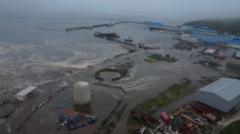The earthquake, which occurred at approximately 11:25 am local time, has been rated among the strongest ever recorded. Video footage from Severo-Kurilsk shows substantial tsunami activity, with large waves flooding buildings and damaging local infrastructure, including a port and a fish processing facility. Power outages have also been reported in parts of Sakhalin, Russia.
Authorities have implemented evacuation orders, leading about 1.9 million people in Japan to seek higher ground, including on rooftops in Hokkaido. Officials in Hawaii have cautioned residents of potential waves reaching up to 10 feet, although as of now, no significant wave impacts have been observed.
As scientists continue to predict the damage potential, it remains difficult to gauge the tsunami's impact. "Some areas could see minimal effects while others may face significant challenges," said Chris Goldfinger, a marine geology expert from Oregon State University. He indicated the severity will largely depend on how the tsunami energy disperses from Kamchatka.
The waves are expected to reach British Columbia and California around 12:20 am local time, and Nome, Alaska by 03:20 am. Despite the earthquake being relatively shallow at a depth of just 19.3 km, it is now tied for the sixth most severe earthquake in history. Comparatively, the catastrophic 2004 Indian Ocean earthquake registered at a magnitude of 9.2-9.3.
This latest seismic event serves as a stark reminder of the potential dangers posed by underwater earthquakes and the global reach of resulting tsunamis.
Authorities have implemented evacuation orders, leading about 1.9 million people in Japan to seek higher ground, including on rooftops in Hokkaido. Officials in Hawaii have cautioned residents of potential waves reaching up to 10 feet, although as of now, no significant wave impacts have been observed.
As scientists continue to predict the damage potential, it remains difficult to gauge the tsunami's impact. "Some areas could see minimal effects while others may face significant challenges," said Chris Goldfinger, a marine geology expert from Oregon State University. He indicated the severity will largely depend on how the tsunami energy disperses from Kamchatka.
The waves are expected to reach British Columbia and California around 12:20 am local time, and Nome, Alaska by 03:20 am. Despite the earthquake being relatively shallow at a depth of just 19.3 km, it is now tied for the sixth most severe earthquake in history. Comparatively, the catastrophic 2004 Indian Ocean earthquake registered at a magnitude of 9.2-9.3.
This latest seismic event serves as a stark reminder of the potential dangers posed by underwater earthquakes and the global reach of resulting tsunamis.



















